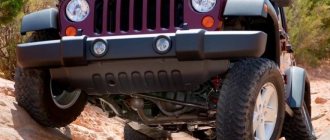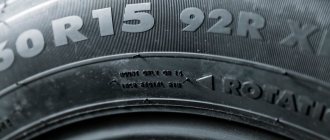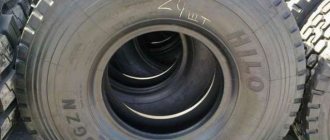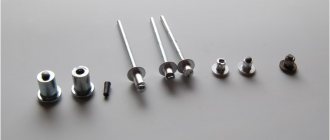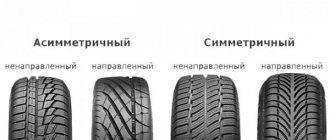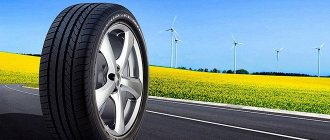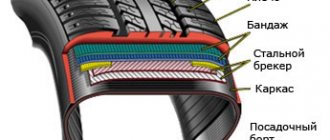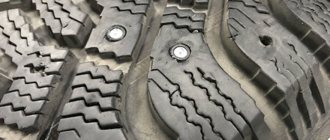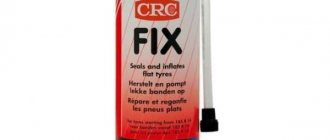Winter tire tread - what is it, what does it consist of?
By tire tread we mean a protective layer of rubber on the surface of the profile, which has a certain pattern. It allows you to achieve an optimal contact patch with the road. In general, the protector has three main functions:
- protection from damage;
- drainage of water from under the wheel;
- ensuring normal traction on slippery surfaces.
The protector consists of several elements.
- Edge. This is the central part of the tread. Present on summer, rain and winter European tires. May not be available on Scandinavian and off-road tires.
- Tread block (checkers). The main element of the pattern provides traction. This is where the spikes are attached.
- Cutting (lamellas). Small cuts on the surface of the “checkers”. Responsible for improving grip.
- Gutter Circular groove. Usually located in pairs, on either side of the rib. On some tires with an aggressive pattern it may be absent.
- Grooves. Recesses separating tread blocks.
- Shoulder. Blocks located at the very edge of the profile. In winter, on snowy roads, it is better to use tires with well-developed shoulder blocks.
What role does tread play in car tires?
A car tire consists of two main parts: the supporting structure and the tread.
The tread covers the front of the tire. This is the outer part of the tire that comes into contact with the road surface. The tread is nothing more than a rubber coating of a certain height and shape, made mainly from synthetic and natural rubber, purified with various additives. These can be oils, elastomers, silica and many others, depending on the tire class and manufacturer.
Types of winter tire tread patterns
In practice, several types of drawing are used. Let's look at the types in more detail.
- Symmetric. The simplest version of the drawing. Both halves of the profile are the same. This is one of the simplest protectors. Often used on inexpensive tire models.
- Symmetrical directional. Differs in the presence of a direction of movement. The grooves are positioned to drain water away from the tire without any problems. Typical for European winter tires.
- Asymmetrical. One side is optimal for wet coating, the other for dry coating. This type of pattern is rarely found on winter tires.
- Asymmetrical directional. One of the best options for any type of winter tires. Since it has not only a universal protector, but also a direction for rotation. This allows you to cope most effectively with any road conditions.
When installing directional tires, you must follow the arrow that indicates the direction of movement of the car. Also on asymmetrical tires there is an inner/outer side indication.
What is the minimum remaining tread depth?
Current road traffic regulations stipulate the minimum remaining tread depth at which winter tires can be used. For the category of cars and trucks weighing no more than 3.5 tons, the minimum tread is 1.6 millimeters. It is prohibited to use such tires with a smaller tread depth.
If the car is used correctly, up to a minimum of 1.6 millimeters, high-quality tires will wear out no sooner than after 4-5 years of tire use. However, this only applies to the correct operation of such winter wheels. If the car owner changes tires in late spring and uses such winter tires on warm and hot asphalt for a long time, this also leads to rapid wear, and as a result, the tires will require replacement literally two to three years after they begin to operate.
Fighting uneven tire wear
Certain difficulties for car owners can be caused by increased wear and tear, which appears with an active driving style or problems with wheel alignment. It should be said that it is easier to combat such uneven wear when using non-directional tires. In this case, the car owner can easily change the right and left wheels, as well as swap tires from the front to the rear axle and back. This ensures their uniform wear, and the tires themselves last as long as possible.
The car owner should also remember that such tires are primarily intended for calm, measured driving. This is explained by the appropriate rubber formula, which retains its properties even in deep minus conditions, but with active use, especially on bare asphalt, rapid wear of the tread is observed, which can lead to complete failure of the tires literally just a few years after they begin operation.
Tread types by purpose
In addition to the pattern, there is also a division by tread type. It is worth understanding this diversity separately. First of all, it is necessary to mention friction and studded tires.
- Friction tires achieve optimal grip due to the tread structure, additional elements and rubber composition. At the same time, the tread pattern of winter tires of this type may vary.
- Studded tires work by having metal studs in the tread. They do an excellent job in situations where there is ice or snow in front of you. There are restrictions on operation in some conditions.
In addition, friction tires are divided into the following types.
- European winter tire treads have a shallow tread pattern. Visually resembles a rain tire. There are practically no lamellas. Such rubber practically does not stud. Used for warm climates with a lot of thaws.
- Scandinavian protector. Here the depth of the pattern is quite large, often reaching 10 mm, and sometimes more. Thanks to the presence of lamellas, it copes well with snow and ice. The composition of the rubber mixture allows the tires not to freeze in almost any frost. Often they are additionally studded, or have sockets for additional studding.
Tire tread height - double in winter
Installing winter tires, replacing winter washer fluid, checking the condition of the battery and purchasing a new windshield scraper. These are the basic steps that the average driver takes before winter. For tires, the most important parameter for most motorists is the tread height. What role does tread play in car tires? Why is his height so great for driving safety? What tread height is required by law? How to measure tread height?
All European countries have regulations governing the minimum tread height of tires. If it is below the established value, there is a fine, but sometimes not only that.
Features of winter tire tread pattern
Let's look at some differences from summer tires.
- The height of the picture is always greater. Even the simplest tires have a depth of 7-8 mm, and a minimum remainder of 4 mm, which is significantly more than that of summer tires.
- The presence of large blocks of different shapes, which makes it possible to work more efficiently in the snow.
- There are special cuts (lamellas) that provide better grip on slippery surfaces.
- The lateral shoulder blocks are clearly pronounced.
As already mentioned, lamellas are an important design element. By providing the blocks with additional mobility, they improve traction. Thanks to this element, friction tires are often not inferior in efficiency to studs. A tire can be equipped with several different types of sipes.
Separately, it is worth mentioning the lamella pumps. They are located on the shoulder blocks. The main feature is the widening of the incision closer to the outer edge of the shoulder. This allows water to be reliably drained from under the car.
Requirements for tires in winter
In winter, the likelihood of an accident increases, and as a result, the demands on tires become greater. The main difference between winter tires and summer tires is the composition of the rubber compound. A winter tire contains more rubber, which makes it more elastic, and with the help of special components, elasticity is maintained during operation at a low temperature range.
In addition to all the above requirements for safety, handling and grip, winter tires must provide them not only on dry and wet surfaces, but also on icy and snowy surfaces, as well as on slushy snow.
Studded tires include winter tires with steel studs in the tread blocks.
As for the performance characteristics of the stud, its grip on ice is an order of magnitude higher than that of conventional Velcro, but the stud has an increased noise level.
Installation diagram of winter tires depending on tread
Their efficiency and safety largely depend on the correct installation of tires. Here you need to take into account the features of the tread. Let's list the main nuances.
- You can install symmetrical non-directional tires in any way you like without restrictions. You can choose any tire and replace it with each other.
- Symmetrical and directional tires. Installed according to the direction indicated by the arrow and the inscription ROTATION.
- Asymmetrical non-directional tires must be installed according to the signs on the outside - outside, on the inside - inside. The direction of movement does not matter.
- The most demanding to install are asymmetric directional tires. They must be placed taking into account the direction of movement and compliance with the sides (internal/external).
The car must have the same tread pattern on all axles.
What tasks does a tire tread perform?
First of all, it must provide optimal grip in all conditions, on dry, wet and loose surfaces, at any speed:
The tread transmits driving and braking forces;
The tread must also provide stability and ability to move;
Tire life depends on the tread material;
Tread resistance also depends on the tread (the lower, the lower the fuel consumption) and ride comfort (this refers to the level of noise generated by the tire).
Remaining tread depth of winter tires
According to the technical regulations for the approval of wheeled vehicles for winter tires, restrictions are introduced on the minimum tread depth of 4 mm. This applies to tires marked as winter or M+S.
Usually there are still manufacturer's marks, usually indicating the minimum permissible depth of 4-6 mm. In practice, traffic police officers cannot rely on the actual erasure of the tag when issuing a fine and prohibiting further movement. For this purpose, only measurements in accordance with the regulations are allowed.
If the wear is greater than normal, it is unsafe to drive the car.
Knowing the features of the tread of winter tires, no difficulties will arise with the selection. You can also monitor the condition of the tires yourself.
From January 1, 2020, paragraph 5.1 of the List of faults and conditions under which the operation of vehicles is prohibited has been changed.
This paragraph sets the requirements for tire tread.
Was: 5.1. Passenger car tires have a residual tread depth of less than 1.6 mm, truck tires - 1 mm, buses - 2 mm, motorcycles and mopeds - 0.8 mm. Note. For trailers, standards for the residual height of the tire tread pattern are established, similar to the standards for tires of vehicles - tractors.
Now: 5.1. The remaining tire tread depth (in the absence of wear indicators) is no more than:
Comments
Slavik 09.22.2016 19:55 Thank you very much, it helped a lot))
Reply | Reply with quote | Quote
Vladislav 10/14/2016 10:10 So, if there are wear indicators, then you can drive the tires to the cord?
Reply | Reply with quote | Quote
Sergey 01/25/2017 21:33 Before the explosion!!!
Reply | Reply with quote | Quote
Vladislav 10/14/2016 10:12 Or until they are visible?
Reply | Reply with quote | Quote
Vlad 10/19/2016 07:03 You can drive until the wear indicator itself begins to cut and wear out. It, if present, can be seen on both new tires and old ones; Ask elementary school students and they will show you where to watch. Well, those who love thrills can drive not only to the cord, but also until the hubs start to be cut off. :)
Reply | Reply with quote | Quote
Vitaly 10/17/2016 12:47 The law says “no more” and not “no less”. Note!
Reply | Reply with quote | Quote
Administrator 10.23.2016 21:28 Vitaly, you are not the first to make such a remark. But your remark is wrong. Operation is prohibited if the remaining tread depth does not exceed a certain value. Those. operation is permitted if the tread depth is greater than this value. A quote from the List of faults is given in the article, it says “no more.” Then in the table the data is indicated in a more understandable format, so it is written “more”. Everything is correct there.
Reply | Reply with quote | Quote
Vladimir 10/18/2016 21:46 correctly written, if more then exploitation is permitted
Reply | Reply with quote | Quote
Gulya 07.11.2016 08:50 Please tell me how to properly check the depth of the tread pattern, I need it for work. I measured it with a caliper and it turned out to be 16 mm on an R 20 tire, the school bus has a mileage of 50,000 km. .
Reply | Reply with quote | Quote
Vladimir 12/19/2016 16:19 Thank you for putting everything in order
Reply | Reply with quote | Quote
Vladimir 04/24/2017 11:16 The author gave an incorrect example for a passenger car. And according to the old law, you can’t drive 1 mm!
Reply | Reply with quote | Quote
Admin 04/24/2017 21:22 Thank you, Vladimir. Corrected the example. Indeed, for passenger cars the limit of the permissible tread pattern height is 1.6 mm, not 1 mm.
Reply | Reply with quote | Quote
Mahmud 05/17/2017 16:20 I have one question. Kamaz fire truck. leading three mosny. I want to know how many mm the tire tread depth is allowed
Reply | Reply with quote | Quote
Update list of comments
Add a comment
JComments
The effect of tire wear on driving
Over time, the tread of car tires wears out, which invariably worsens vehicle control and significantly reduces its stability. It is known that on wet asphalt or soil, the braking distance increases if the tires are significantly worn. In this regard, many manufacturers make the tread pattern and depth in such a way as to significantly shorten the braking distance.
Also, on a wet road surface, worn-out tires can cause an accident. If the tread depth is below the permissible value, aquaplaning may occur. It occurs due to the fact that the rear and front wheels begin to rotate at different speeds. One of the front wheels ends up on the surface of the water, thereby losing traction with the road surface, causing the car to skid while driving. This may result in the driver losing control of the vehicle and causing an accident. Worn tires can cause:
- difficult control in bad weather;
- increasing braking distance on ice, snow or wet roads;
- deterioration in braking quality due to reduction in wheel weight.
You should not assume that worn-out tires only worsen vehicle performance in rainy weather and snowfall. When driving on a dry road, vehicle stability is significantly reduced (primarily this applies to vehicles without EPS systems responsible for directional stability).
Summer tire tread height
For a regular passenger car, the tread height of new tires is 7.5-8.5 mm . Provided that you purchase tires for driving on public asphalt roads.
If the car owner is the owner of an SUV or crossover and often goes off-road, the tread depth should be around 17 mm, due to the protruding cups and lugs.
Just in case, let us remind you that from January 1, 2020, new clauses were introduced into the rules for admitting vehicles to operation, according to which the residual tread depth cannot be less than 1.6 mm for passenger cars. This applies to both summer and winter tires. Although, it is advisable to install new tires when the tread has worn down to 2 mm. There is a special icon on the court - TWI, which determines the degree of wear.
Truck and off-road tires
Truck tires are not divided into summer and winter. They initially come with a powerful deep tread designed for a specific type of coating.
For example, the depth of our popular designs - diamonds, houndstooth - also depends on the standard size:
- 240/260-508 (ZIL, GAZ-3307) - 16.3-18.3 mm;
- 280/300/320-508 (LAZ, MAZ, KamAZ, ZIL) - up to 23 mm.
Well, for special rubber, for example for mining dump trucks, there are special requirements and the depth can significantly exceed the specified values.
